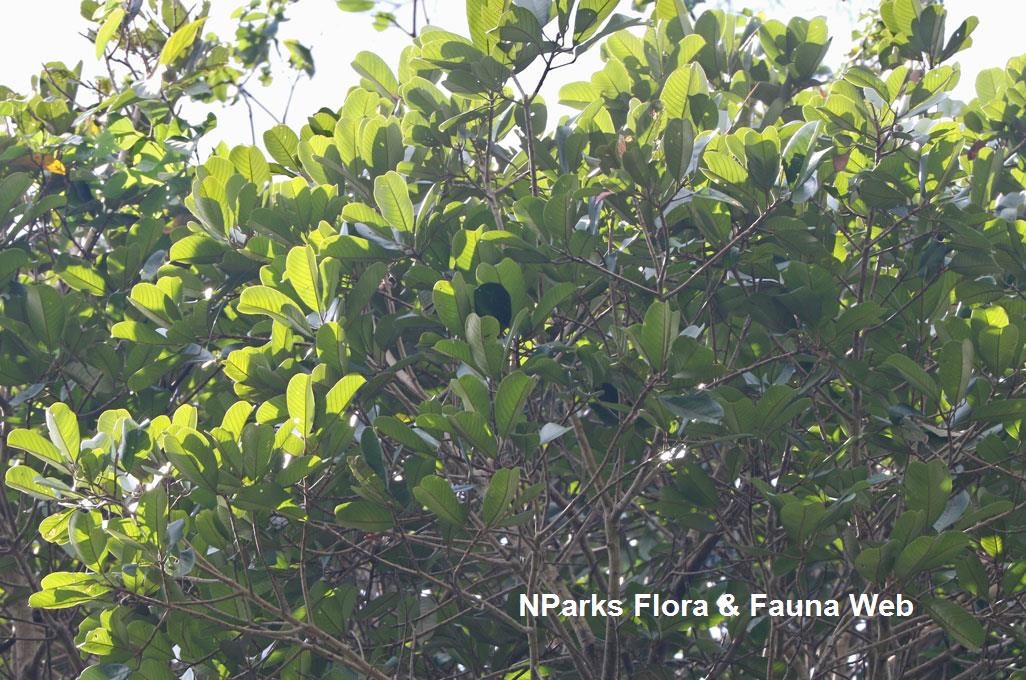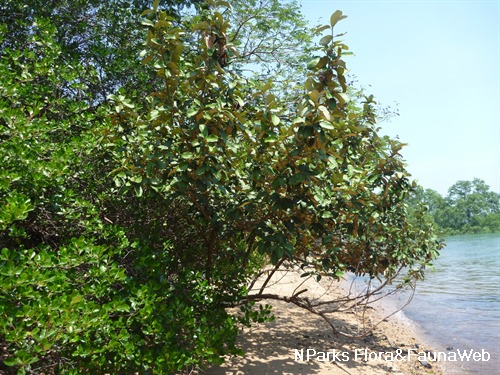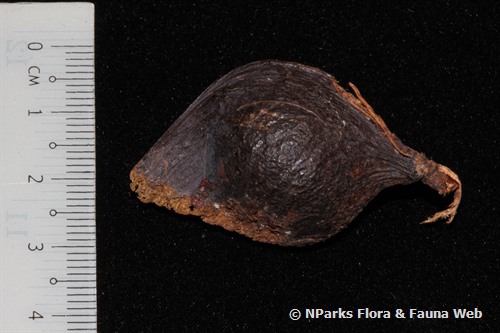.jpg)
Back
Heritiera simplicifolia (Mast.) Kosterm.
| Family Name: | Malvaceae |
| Common Name: | Mengkulang Siku Keluang |
Heritiera simplicifolia or Kembang is a tall tree that reaches 50 m in height. When young, the seedling and saplings produce compound, palmate leaves. As it matures, the leaves become simple, alternately arranged. Kembang produce tiny bell to urn-shaped flowers of up to 2 mm long and attractive green-red, single winged fruit.
Name
Classifications and Characteristics
| Plant Division | Angiosperms (Flowering Seed Plants) (Dicotyledon) |
|---|---|
| Plant Growth Form | Tree (Big (>30m)) |
| Lifespan (in Singapore) | Perennial |
| Maximum Height | 50 m |
Biogeography
| Native Distribution | Borneo, Malaya, Philippines, Sumatera, Thailand and Singapore |
|---|---|
| Native Habitat | Terrestrial |
| Preferred Climate Zone | Tropical |
| Local Conservation Status | Native to Singapore (Endangered (EN)) |
Description and Ethnobotany
| Growth Form | It is large, tall tree up to 50 m tall. Buttresses are thin, large up to 3 m high. |
|---|---|
| Foliage | Its alternate, stalked leaves are thick and leathery. The broadly elliptic or narrow spoon-shaped leaves are 3.5 - 10 cm wide by 6 - 17 cm long, covered with tiny star-like scales below. Its midrib is raised above. During the seedling and sapling stage, the leaves are palmate and compound. |
| Flowers | Its flowers are very small, bell to urn-shaped, up to 2mm long. Flowers are borne on a paniculate inflorescence with reddish brown soft hairs. |
| Fruit | Its fruit green-red coloured, produced in clusters. The single winged fruit is about 10 cm long and 3 cm wide, contains a single nut measuring 1.5 cm long and 1.2 cm wide. |
| Habitat | It grows in lowland forests and on low hills and ridges with sandy soil up to 600 m altitude. |
| Cultivation | It can be propagated by seed. |
| Etymology | Latin Heritiera, commemorating Charles Louis L’Heritier de Bautelle (1746-1800), a French botanist and author; Latin simplicifolia, simple leaf, referring to the leaf having an undivided leaf blade. |
Plant Care and Propagation
| Light Preference | Full Sun |
|---|---|
| Water Preference | Moderate Water |
| Plant Growth Rate | Slow |
| Rootzone Tolerance | Fertile Loamy Soils, Moist Soils |
Foliar
| Foliage Retention | Evergreen |
|---|---|
| Mature Foliage Colour(s) | Green |
| Foliar Type | Simple / Unifoliate |
| Foliar Arrangement Along Stem | Alternate |
| Foliar Attachment to Stem | Petiolate |
| Foliar Shape(s) | |
| Foliar Venation | Pinnate / Net |
| Foliar Margin | Entire |
| Foliar Apex - Tip | Obtuse, Truncate, Emarginate |
| Foliar Base | Acute |
Non - Foliar and Storage
| Stem Type & Modification | Woody |
|---|---|
| Root Type | Underground (Tap Root) |
Floral (Angiosperm)
| Flower & Plant Sexuality | Unisexual Flowers , Unisexual Flowers |
| Flower Texture(s) | Velvety / Furry / Tomentose |
|---|
| Flower Grouping | Cluster / Inflorescence |
| Flower Location | Axillary |
| Flower Symmetry | Radial |
| Individual Flower Shape | Urceolate / Urn-shaped, Campaulate / Bell-shaped |
| Inflorescence Type | Panicle |
| Flowering Habit | Polycarpic |
Fruit, Seed and Spore
| Mature Fruit Colour(s) | Green, Pink, Purple, Red |
|---|---|
| Fruit Classification | Simple Fruit |
| Fruit Type | Indehiscent Dry Fruit , Samara |
| Seed Quantity Per Fruit | Few (1-5) |
References
| References | Kostermans, A.J.G.H. (1959). A monograph of the genus Heritiera Aiton (StercuL) (including Argyrodendron F. v. M. and Tarrietia Bl.). Reinwardtia, vol. 4. Indonesia: Herbarium Bogoriense. |
|---|
Image Repository
Others
| Master ID | 29986 |
|---|---|
| Species ID | 4295 |
| Flora Disclaimer | The information in this website has been compiled from reliable sources, such as reference works on medicinal plants. It is not a substitute for medical advice or treatment and NParks does not purport to provide any medical advice. Readers should always consult his/her physician before using or consuming a plant for medicinal purposes. |


.jpg)

